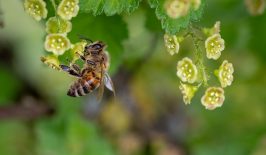May 20th is World Bee Day, an important day in history: today, back in 1734, Anton Janša, the pioneer of beekeeping, was born. And while he might enjoy people celebrating his big day, it’s unlikely that he’d be happy with how he finds the planet and its bee population some 285 years later.
The importance of World Bee Day is best reflected in the changing perception of our place in the world, nature, and our Earth. Hurting bees hurt us – pollinators are under pressure, which directly affects our farming. As we listen to the world around us more closely, technology and innovations are supporting bees through listening as well.
On World Bee Day 2019, here are three projects and movements making a digital difference for bees, and not always in expected ways!
Listening to local hives: Beekeepers using sensors
OSBeehives offers one of the leading “smart” solutions for beekeepers, offering a beehive monitoring IoT device called BuzzBox. Solar-powered and connected to Wi-Fi, the device relays audio, temperature, and humidity signals out of the hive and into datasets. These are analyzed using algorithms that offer machine learning to predict the health of hives and provide alerts for unhappy colonies. It also offers anti-theft monitoring, providing assurances for an unfortunately common event.
An additional smartphone app provides remote monitoring of hive measurements and alerts from the BuzzBox. In addition, a smartphone can be used to record beehive audio which can also be analysed using BuzzBox software, with more features being rolled out.
Pleasingly, OSBeehives has made much of its solution open source as well, providing sensor designs, software, and even unique hive designs for those that don’t mind some DIY. For everyone else, the BuzzBox starts at $199.
Listening to global hives: The World Bee Project
The World Bee Project and IT giant Oracle are taking the OSBeehive idea further, building a global network of AI “smart hives”. The idea is to provide as much real-time data as possible to scientists to better understand bees and their environments. We know bees struggle to prosper when fighting increasing pollution, loss of habitats, parasites and mites, and more factors. But knowing exact details, and identifying early warning signs at scale, are not well understood.
The World Bee Project mounts up to six sensors on hives, which will then capture the same BuzzBox data: sound, hive temperature, and humidity, as well as adding additional capabilities including tracking relative movement of bee wings and feet, the weight of accumulated honey and pollution levels. Much of this effort is going into attempting to limit the amount of swarming, where more than half a hive splits to follow a queen to create a new colony. While this is good for creating new bee colonies, it can be in reaction to an unhealthy hive in the first place. Early warning signs would provide better conditions for bees.
Listening to… adult stars? It’s all for the bees!
One unexpected pro-bee effort comes from the adult industry. P-rnHub launched the “BeeSexual” channel on its famously adult webpage, which features bees and flowers, and some graphic audio that tells us exactly what the busy bees are up to.
P-rnHub has said for every view of a ‘BeeSexual’ video, the company will donate undisclosed sums to bee charities such as Operation Honey Bee and The Center for Honeybee Research. You can find out more at this link, and while it’s probably fairly PG to be watching bees, much of the rest is probably NSFW for most people.
Of course, there’s always more we can do to help bees, and it doesn’t just have to be through digital innovations. You can buy a pack of wildflower seeds and plant them to help provide food and shelter to the pollinators, or you can join in and sign Greenpeace Europe’s petition demanding a ban on bee-killing pesticides, with 541,000 signatures already received.






